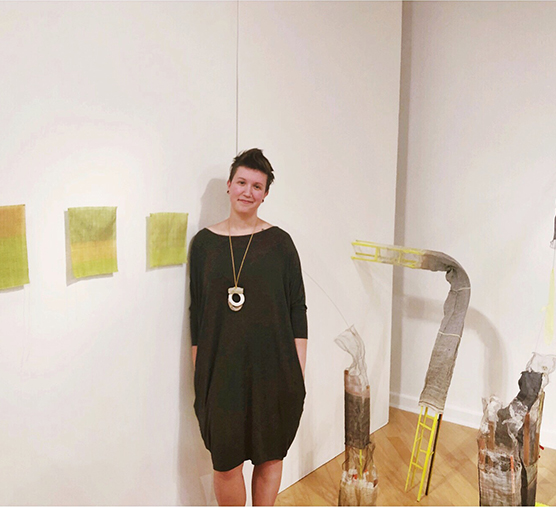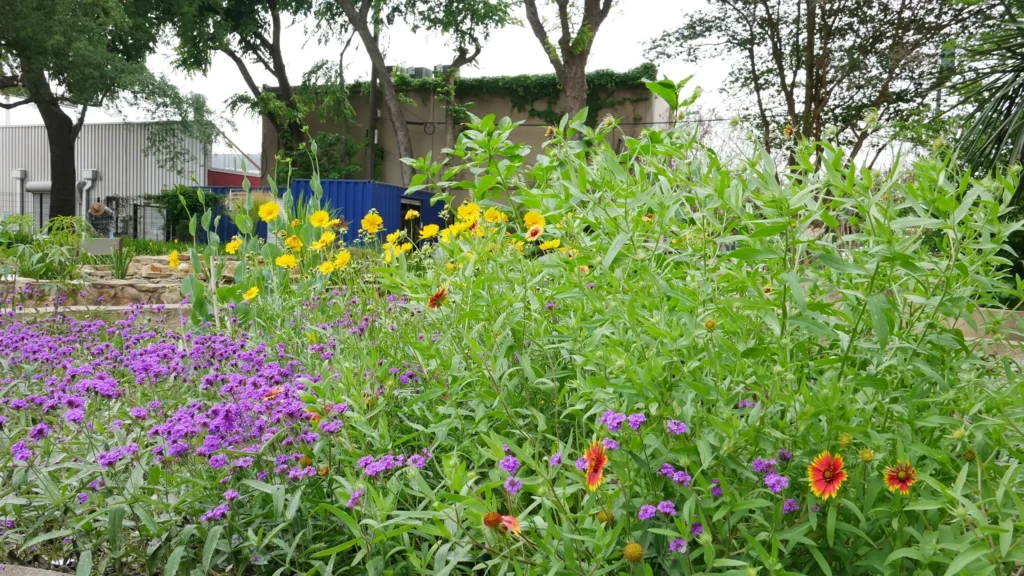
Photo of Molly Koehn with her installation in the exhibition, “Chromatic Drift” (2018), at Texas A&M International University Art Gallery. Photo by Sarah Darro.
This summer, HCCC Curatorial Intern Cydney Pickens is interviewing some of the artists featured in HCCC’s Artist Residency Program Project Space. She recently spoke with environmental artist and former resident, Molly Koehn. Read on to discover how patterns of human nature and the Gaia Theory influence Koehn’s work.
For my first interview with a resident artist here at the Houston Center for Contemporary Craft, I had the pleasure of interviewing environmental artist Molly Koehn. As HCCC’s curatorial intern, part of my duty is to study the artworks beyond what meets the eye. I met with Molly at her studio with the intention of getting to know more about her work and the thought process behind it.
Before becoming a resident at HCCC, Molly completed her MFA in fiber at Arizona State University. Using her loom to weave steel fibers alongside natural fibers such as cotton, silk, and linen, Molly creates intricate and delicate structures that challenge our perspective on relative permanence and our interactions with the environment. Her work, Structure 10 (2018), was recently on view inside HCCC’s Project Space through June 20th, 2018. This piece is not only Molly’s favorite piece that she has created but the first piece she has made since relocating to Houston.
Molly moved to Houston in September, 2017, from Phoenix, Arizona. She prefers to live in large cities rather than small towns because they provide her with the opportunity to observe larger groups of people interacting with their environment. These large concentrations of people, which she calls “environmental agents,” are symbolized in her work, Structure 10, as neon-colored pieces of flagging tape. The bright neon color clashes against the subdued hues of the natural fibers, highlighting the prominent impact of humans in nature. Having lived in rural areas as well, Molly notes that “we create the environment we want, instead of appreciating the environment that is there.” As is evident here in Houston, there is much construction and development that accompanies a growing population, yet there must be some sort of balance to compensate for these changes.
Molly’s work investigates the relationships between humans and their environment, often pertaining to the ideals of the Gaia theory. Developed by James Ephraim Lovelock in the late 1960s, the Gaia theory postulates Earth as a living organism that makes necessary adaptations for survival, independently of the humans, plants, animals, and other organisms that depend on it. In other words, Earth, both self-regulating and self-sufficient, has the intrinsic ability to gradually alter the climate, weather, or atmosphere in response to changes caused by humans including those relating to pollution, carbon emissions, deforestation, and urban development. According to the theory, there must be a balance between the amount of construction and destruction happening in a given area.

Molly Koehn, “Structure 10,” 2018. Handwoven steel, silk, linen nylon, wood, wire stock, flagging tape, AstroTurf, clamp lights. Photo by Scott Cartwright.
In Structure 10, Molly demonstrates this delicate balance with two large structures connected by steel arcs. Although these arcs are tethered to one another, their positioning is precarious. The fragility of a balanced ecosystem is emphasized in her ephemeral works by the thin veil of woven steel and silk. The harmony of the manufactured steel fiber and the organic silk fibers is disrupted by Molly’s intentional bleaching process. This process degenerates the weaving by exposing the steel and eroding the silk, leaving a jagged line of demarcation that gradually recedes as the bleach continues to consume the silk. Considering the aggressive and continuous effects of the bleach, Molly’s artworks will never look as they did when they were created.
In my interview, I was interested to learn Molly’s stance on the conservation of ephemeral artworks and the amount of interference that should be allowed by an art conservationist. According to Molly, all of her works are ephemeral, and whether they are transfigured or disfigured by the elements of their environment, they maintain the same level of artistic integrity and value. Once on display, an artwork is subject to physical changes from its surrounding environment, and the response of the materials to these external stimuli captures both the ephemerality of Molly’s work and its relevance to the Gaia theory.
Molly’s next show will be hosted at the Mary Matteson-Parish Art Gallery at Lonestar College Montgomery. Her work will be on view August 27 through September 14th. Soon after, in early 2019, Molly will be exhibiting her artworks in an outdoor setting for the first time at Art League Houston’s Sculpture Garden, expanding her talents from environmental artwork to land artwork as well. I look forward to seeing both of these exhibitions as well as her future projects.

